Barzan Towers
Barzan Towers (Arabic: برج برزان "High Place"), also known as the Umm Salal Mohammed Fort Towers, are watchtowers that were built in the late 19th century and renovated in 1910 by Sheikh Mohammed bin Jassim Al Thani.[1][2] They are located at the southern side of the defensive system established at the end of the 19th century and start of the 20th century to protect the 'rawdat', a valley where precious rainwater is collected when it flows down from higher ground. In Arabic "barzan" means "high place".[1][2]
| Barzan Tower | |
|---|---|
برج برزان Umm Salal Mohammed Fort Towers | |
| Umm Salal Mohammed, Umm Salal, | |
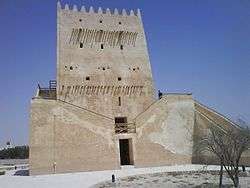 Barzan Tower (with staircases). | |
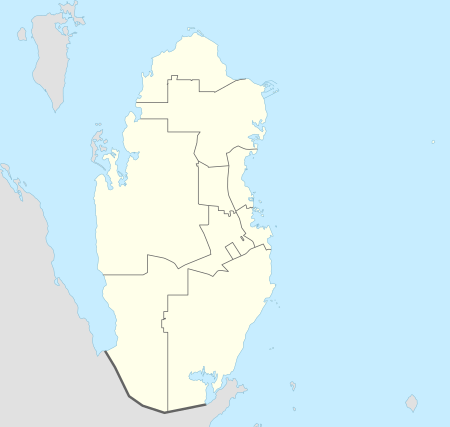 | |
| Coordinates | 25.418024°N 51.413094°E |
| Type | Historical Watchtowers |
| Height | 16 m (52 ft) |
| Site information | |
| Owner | |
| Controlled by | Late 19th century–present: |
| Site history | |
| Built | Late 19th century |
| In use | 1910–2003: Watchtowers 2003–present: Museum |
The buildings were restored in 2003. The towers measure 16 metres (52.49 ft) high.[2] The fort links to two other fortified buildings towards the west and another tower towards the north. Barzan Towers may have been built near the sea to keep an observant eye on pearl divers, as a look-out for approaching ships, and as an observatory for keeping track of the moon.[2][3] The Barzan Towers have been rebuilt with features such as air-conditioners.[1]
Originally built with coral rock and limestone cementing the structures featured traditional Qatari design and building methods including "marazim" wooden to drain rainwater during storms away from the building walls, a "majilis" room between the towers to receive guests, and four-layer roofs with "danchal" wood pole construction, 'basgijl,' woven bamboo strips, mangrove mesh and a layer of compressed mud.
History
The Barzan Towers were built in the late 19th century[4] and were renovated by Sheikh Mohammed bin Jassim Al Thani in the early 20th century to serve as watchtowers against the incoming Ottoman soldiers. Although his father had defeated the Ottomans several years before in the Battle of Al Wajbah, Mohammed remained weary of renewed military tensions. They were also used by the native Qataris to scrutinize the new moon during the holy month of Ramadan, since keeping track of the moon was essential. The towers were restored in 2003 by the Qatari authorities.[2][3]
Geography
The Barzan Towers are situated on a low hill called Jebel Lusail in the town of Umm Salal Mohammed,[5] in the municipality of Umm Salal that is about 10 km from the coast and 15 km north of Doha, the capital city of Qatar. On one side of the towers, huge, modern houses stand, while on the other, makeshift shacks exist. The former fortified house, or sometimes referred to as castle, of Sheikh Jassim bin Mohammed Al Thani is located beside the towers. A unique oasis full of green trees, animals and palm trees can also be found behind the towers.[2][3]
Structure
The Barzan Towers have walls which are one meter thick, especially in the base, and are further reinforced and toughened by buttresses. One tower has walls in the form of cones and massive and enormous staircases in the other. These walls were built by first merging and blending overlapping raw pieces of coral stones with limestone and cementing the two with a mud mortar after, which is somehow, similar to the construction of the walls of the Zubarah Fort. The walls were then covered with a gypsum-based plaster once dry. The Barzan Towers have a roof that was built with four layers. The first layer is composed of a series of "danchal" wood poles, which were sometimes painted with bitumen for protection. The "danchal" poles were then covered by a layer of "basgijl", a layer of woven bamboo strips. A carefully constructed net of mangrove branches was added, followed by a layer of compressed mud to protect the towers from the sun during the hot summers. The towers were also built with some external features such as a room for receiving guests, called "majilis", which was built as an L-shaped pavilion with windows for ventilation, and a mosque which has a prayer room that was also used as a school for teaching the Quran to children, called "madrassa". Traditional "marazims" protect the walls' surfaces and were built as wooden channels that stretch out from the roof to drain rainwater just in case heavy, but rare and uncommon, thunderstorms and other types of storms strike the desert. The "marazims" were built on top of the "majilis" and the mosque.[2][3]
Schedule
The Barzan Towers are open to visitors for 24 hours. On the other hand, several surrounding landmarks, such as the house of Sheikh Jassim bin Muhammed Al Thani, the Umm Salal Fortresses and other additional towers of the forts, are closed for visitors since they are private property.[2][3]
Gallery
Click on the thumbnail to enlarge.
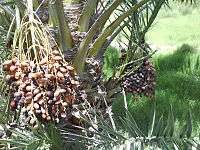 Date palms in the oasis near the Barzan Towers, showing signs of vegetation in the barren desert.
Date palms in the oasis near the Barzan Towers, showing signs of vegetation in the barren desert.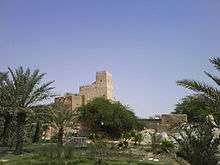 Barzan Tower (with cones), viewed from the side.
Barzan Tower (with cones), viewed from the side.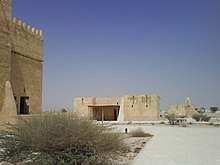 Umm Salal Muhammed Fort
Umm Salal Muhammed Fort
See also
- Lusail
- Al Koot Fort
- Zubarah Fort
References
- "Barzan Towers: Qatar Visitor". Qatarvisitor.com. Archived from the original on 2012-10-24. Retrieved 2012-11-16.
- "Forts :: Qatar Tourism Authority". Qatartourism.gov.qa. Archived from the original on 2012-06-17. Retrieved 2012-11-16.
- "Barzan Towers :: Explore-Qatar.com". Explore-qatar.com. Archived from the original on 2012-12-12. Retrieved 2012-11-16.
- Zahi Hawass (30 May 2013). "أم صلال محمد.. تاريخ وتراث" (in Arabic). Asharq Al Awsat. Retrieved 29 July 2015.
- R. Hawker (10 June 2008). "Traditional Architecture of the Arabian Gulf: Building on Desert Tides". WIT Press. p. 148.